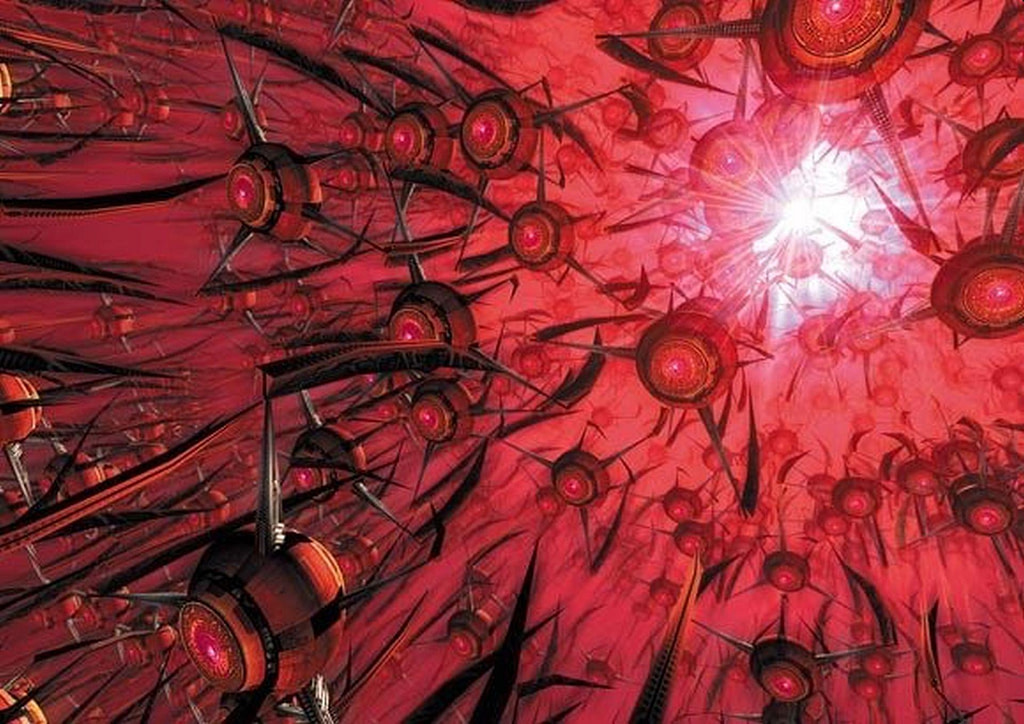Nanotechnology would allow in principle to arrange atoms in any way we want. If this comes true, the world will forget what scarcity means because everything is made of atoms. This will move us into the future of abundance. As the philosopher Jason Silva puts it in “Future of Everything “It essentially makes the physical world a programmable medium.”
One such scenario includes building the so-called nano-factory, a hypothetical device that could manufacture products with absolute atomic precision for a fraction of the cost of current manufacturing (Drexler, 14/3/2006). “Atomic precision” here means that two objects produced by a nano-factory, for example two computers of the same design, would be identical with respect to not only their macroscopic properties, but also the precise placement of their constituent atoms. It remains unclear whether nano-factories are physically possible, but if they are, as theorists like Eric Drexler of the Future of Humanity Institute and Ralph Merkel of Singularity University claim, then the consequences for humanity would be profound.
There are only three resources required to operate a nano-factory: power, design instructions and a simple feedstock molecule such as acetone or acetylene. With these three conditions met, terrorist groups and lone wolves of the future could potentially manufacture huge arsenals of conventional and novel weaponry, perhaps eluding detection by law enforcement or international regulatory bodies. Nano-factories might even be capable of making nuclear weapons, although at present this possibility is uncertain. (Drexler, 14/3/2006)
Molecular manufacturing requires significant advances in nanotechnology, but once achieved it will be possible to produce highly advanced products at low costs and in large quantities in nano-factories of desktop proportions. When nano-factories gain the ability to produce other nano-factories, production may only be limited by relatively abundant factors such as input materials, energy and software. Being equipped with compact computers and motors these could be increasingly autonomous and have a large range of capabilities (Phoenix, 2008).

However, ultra-precise manufacturing on an atomic scale, which could create materials with wonderful new properties, could also be used in frightening new weapons. There is even a possibility to create self-replicating nano-machines taking over the planet.
Phoenix and Treder classify catastrophic risks posed by nanotechnology into three categories:
- From augmenting the development of other technologies such as AI and biotechnology.
- By enabling mass-production of potentially dangerous products that cause risk dynamics (such as arms races) depending on how they are used.
- From uncontrolled self-perpetuating processes with destructive effects (Phoenix i inni, 2008).
This last speculative threat involves the intentional design of autonomous “nanobots” that would convert all the matter in their vicinity into clones of themselves. The result would be a positive feedback effect that could destroy the entire biosphere in as little as 90 minutes, according to a 2006 calculation by Ray Kurzweil in his book “The Singularity Is Near: When Humans Transcend Biology” (Kurzweil, 2006). You may disagree with this prediction, but many existential risks experts take it seriously.
If you cannot imagine self-replicating nanobots, the size ranging from less than a millimetre to a few millimeters then have a look at a snowflake which is replicated from water molecules each time the weather conditions are right. But perhaps even a better example is your DNA molecule. Human DNA consists of over 3bn base pairs contained in 23 chromosome pairs. The thickness of the pages on which I am typing this text is roughly equal to a human hair, i.e. about 100,000 nanometres. But a strand of human DNA is just 2.5 nanometres in diameter, about 40,000 times thinner. In most simple terms, DNA has a property to replicate itself, modify and repair errors but in the end, it works like an unusual computer code, which always makes a copy of itself. It uses the original like one part of a ‘zip’ to create the second part of the ‘zip’. If it is placed in an appropriate growing environment, it creates billions of proteins, then cells, and tissues until it ultimately creates a living organism, which can then again reproduce. This is biology at its best.
However, a similar process can be developed for a non-biological environment, where atoms are bound into molecules, say mainly based on silicon rather than carbon, forming non-biological building blocks, an equivalent of human cells, which have been originally programmed to become a very small micro motor, still retaining the capability embedded in that motor, of replicating itself and creating billions of such motors ad infinitum. Such nanobots would behave like cancer and would ‘eat’ anything they could in order to create more copies of themselves or built new objects based on the instructions either retained in their ‘DNA code’, or received via Internet cloud. They could of course be affected by the same principle of evolution as a biological DNA and after a few years, produce objects that were never intended. And that unpredictability is the biggest danger.
Some experts in nanotechnology risk field suggest that the existential risk from that area comes from reaching technological advantage in arms race through the availability of nanotech weaponry, which may destabilize a relative current balance between major powers. They list several reasons:
- A large number of players may be tempted to enter the race since the threshold for doing so is low;
- The ability to make weapons with molecular manufacturing will be cheap and easy to hide;
- Therefore, lack of insight into the other parties’ capabilities can tempt players to arm out of caution or to launch pre-emptive strikes,
- Molecular manufacturing may reduce dependency on international trade, a potential peace-promoting factor;
- Wars of aggression may pose a smaller economic threat to the aggressor since manufacturing is cheap and humans may not be needed on the battlefield. (Phoenix, et al., 2008)
In addition, advanced nanotechnologies could introduce new nanoparticles to the biosphere, some of which could prove extremely toxic.

Comments